

The First Time NASA Docked with a Soviet Spacecraft in Orbit. Holy Crap, We've Been Living in Space for 15 Years! How Ta-Nehisi Coates Inspired a Book About the Hunt for Vulcan. This Glittery Gem is in Orbit Helping us Measure the Shape of our Planet. Zugi comments on Redditor explains why we stopped going to the moon and why the space shuttles never fulfilled their promise, and how it was Nixon's fault. Jeffp12 comments on This photo from the Moon was in color. The Truth Behind The Million Dollar Space Pen Hoax. US Spacesuits - Album on Imgur. LGM-25C Titan II.
"Titan II" redirects here.
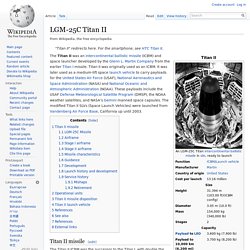
For the smartphone, see HTC Titan II. Titan-II ICBM silo test launch, Vandenberg Air Force Base Titan II launch vehicle launching Gemini 11 (September 12, 1966) Titan 23G launch vehicle (Sept. 5, 1988) All the Robotic Space Explorers since 1958. Kinja is in read-only mode.

We are working to restore service. Why do they show the Pioneers and Voyagers as looping around the planets? Didn't they just skim them? Except for the ones that actually went into orbit around Jupiter and Saturn (i.e. Galileo and Cassini), all the others just bent their trajectories a little bit. Flagged. Lunar Mission Timeline. Dr. Robert H. Goddard stands next to the worlds first liquid propelled rocket in 1935 : space. Building It - The Space Shuttle Orbiter. Great post, but if any of you really want to delve deep, you should pick up a copy of Dennis R.
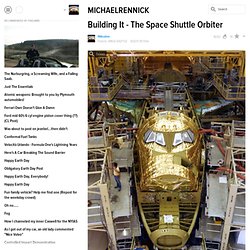
Jenkins' book on the history of the Shuttle's development. Ordered! This post was mostly an excuse to show the cool assembly pictures I found when I put my mind to looking for them. I would also recommend Stages to Saturn. It does a deep dive on the Saturn V. Why did they mock Robert Goddard's dream of space flight?
Alexey Leonov. Alexey Arkhipovich Leonov (Russian: Алексе́й Архи́пович Лео́нов, IPA: [ɐlʲɪˈksʲej ɐˈrxʲipəvʲɪtɕ lʲɪˈonəf]; born 30 May 1934 in Listvyanka, West Siberian Krai, Soviet Union) is a retired Soviet/Russian cosmonaut and Air Force Major General.

On 18 March 1965, he became the first human to conduct extra-vehicular activity (EVA), exiting the capsule during the Voskhod 2 mission for a 12-minute spacewalk. Biography[edit] Alexey Leonov (left, back row) with fellow cosmonauts in 1965. Soyuz 11. Soyuz 11 (Russian: Союз 11, Union 11) was the first and only manned mission to board the world's first space station, Salyut 1 (Soyuz 10 had soft-docked but had not been able to enter due to latching issues).[5] The mission arrived at the space station on 7 June 1971 and departed on 30 June.
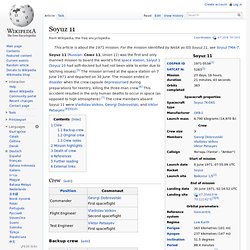
The mission ended in disaster when the crew capsule depressurised during preparations for reentry, killing the three-man crew.[6] This accident resulted in the only human deaths to occur in space (as opposed to high atmosphere).[7] The crew members aboard Soyuz 11 were Vladislav Volkov, Georgi Dobrovolski, and Viktor Patsayev.[8][9][10] Crew[edit] Backup crew[edit] Original crew[edit] Crew notes[edit] The original prime crew for Soyuz 11 consisted of Alexei Leonov, Valeri Kubasov and Pyotr Kolodin. Mission highlights[edit] The Soyuz 7K-OKS spacecraft was launched on 7 June 1971, from Baikonur Cosmodrome in central Kazakh SSR. Death of crew[edit] It quickly became apparent that they had asphyxiated. Thurgood_Marshall comments on Did Neil Armstrong and Buzz Aldrin take suicide pills with them to the moon?
Star Trek Space Shuttle Enterprise Now Available For All To See. There’s a sight and a sound to behold as you step through the door of the Space Shuttle Pavilion, situated upon the flight deck of the Intrepid Sea, Air & Space Museum in New York City. The sight is the Space Shuttle Enterprise, the prototype craft that signaled the era of the reusable spacecraft had begun when it rolled out of Rockwell’s Air Force Plant 42 in Palmdale, California, in 1976. Now retired, the Enterprise is a massive and masterful, not to mention still-majestic piece of living history protected by the Pavilion’s walls. The sound – and it’s really the first thing you hear – is the voice of Star Trek legend Leonard Nimoy, who narrates an informative short film that traces the dramatic history of Enterprise and NASA’s space shuttle program. This morning, StarTrek.com attended a bustling ribbon-cutting ceremony and the public opening of the Space Shuttle Pavilion.
Webster Presbyterian Church - Lunar Communion. "Now Neil and I were sitting inside Eagle, while Mike circled in lunar orbit, unseen in the black sky above us.

In a little while, after our scheduled meal period, Neil would give the signal to step down the ladder onto the powdery surface of the moon. So I unstowed the elements in their flight packets. I put them and the scripture reading on the little table in front of the abort guidance system computer. Then I called back to Houston. 'Houston, this is Eagle. Salyut programme. Salyut 7, the final Salyut station to be launched, as seen from the departing Soyuz T-13 spacecraft The Salyut programme (Russian: Салю́т, IPA: [sɐˈlʲut], Salute or Fireworks) was the first space station programme undertaken by the Soviet Union, which consisted of a series of four crewed scientific research space stations and two crewed military reconnaissance space stations over a period of 15 years from 1971 to 1986.
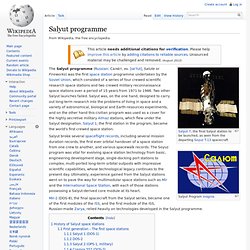
Two other Salyut launches failed. Laika. Cosmonaut Crashed Into Earth 'Crying In Rage' : Krulwich Wonders... Editor's Note, Updated April 24, 2012: We received many comments and questions on this post, which you can read here.
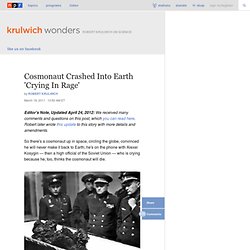
Robert later wrote this update to this story with more details and amendments. So there's a cosmonaut up in space, circling the globe, convinced he will never make it back to Earth; he's on the phone with Alexei Kosygin — then a high official of the Soviet Union — who is crying because he, too, thinks the cosmonaut will die. hide captionVladimir Komarov's remains in an open casket RIA Novosti/Photo Researchers Inc. First dog in space died within hours. The dog Laika, the first living creature to orbit the Earth, did not live nearly as long as Soviet officials led the world to believe. The animal, launched on a one-way trip on board Sputnik 2 in November 1957, was said to have died painlessly in orbit about a week after blast-off. Now, it has been revealed she died from overheating and panic just a few hours after the mission started. 5 Soviet Space Programs That Prove Russia Was Insane. The thing about the Iron Curtain is that we'll never fully know what crazy shit went on behind it during the Cold War.

And that's too bad, because the little hints that leak out really make it look like these people just did not give a shit. Take the Soviet space program. Lost Cosmonauts. Lost Cosmonauts, or Phantom Cosmonauts, is a conspiracy theory alleging that Soviet cosmonauts entered outer space, but without their existence having been acknowledged by either the Soviet or Russian space authorities.
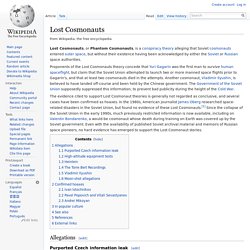
Proponents of the Lost Cosmonauts theory concede that Yuri Gagarin was the first man to survive human spaceflight, but claim that the Soviet Union attempted to launch two or more manned space flights prior to Gagarin's, and that at least two cosmonauts died in the attempts. Another cosmonaut, Vladimir Ilyushin, is believed to have landed off-course and been held by the Chinese government. Yuri Gagarin. Gagarin became an international celebrity, and was awarded many medals and titles, including Hero of the Soviet Union, the nation's highest honour. Vostok 1 marked his only spaceflight, but he served as backup crew to the Soyuz 1 mission (which ended in a fatal crash). Gagarin later became deputy training director of the Cosmonaut Training Centre outside Moscow, which was later named after him. Gagarin died in 1968 when the MiG-15 training jet he was piloting crashed.
Laika: The First Earthling in Space. Original image source at RASA Not all scientific achievements are made by man. In fact, one of the greatest accomplishments was made by a dog. Earthrise. "Earthrise" taken on December 24, 1968. Discarded rockets of the Apollo 11 voyage. Found at the bottom of the Atlantic ocean by Amazon.com's billionaire, Jeff Bezos. [2200×1470]. : AbandonedPorn. 1977048_776329322388081_1786716569_n.jpg (468×693) Keeping in Touch with Our Space Explorers.